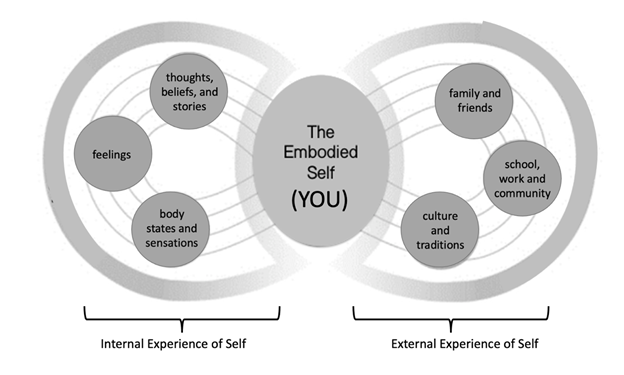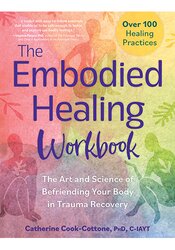Befriending the Body in Trauma Recovery
FREE worksheet from The Embodied Healing Workbook

Trauma can change the way our clients feel about, and in, their bodies. That’s because trauma shifts how the body functions. In the midst of a traumatic experience, our bodies do the very best they can to keep us safe. They courageously and imperfectly attempt to manage the unmanageable by activating our stress response system, which functions to separate us from danger and pain. And when the traumatic event is over, our bodies hold onto the memory of what happened so they can make sure we never hurt in this way again.
Therefore, trauma not only resides in our thoughts‚ÄĒas memories, images, and fears about what might happen‚ÄĒbut also in our bodies. While it‚Äôs true that we think about traumatic experiences after the fact, the truth is we also feel them deeply: in our hearts, nervous systems, muscles, and so often, in our bones. When trauma happens, it is our minds, hearts, and our bodies that are overwhelmed, incapacitated, and ultimately traumatized.
And when the trauma is over, it can feel like our bodies are no longer our partners in being in this world. The body can become defensive or unpredictable, and it can make us feel out of control or shut down. That means that even if we have a really good understanding of why something happened, how it happened, and what to do if it happens again, it can still be difficult to move on because our bodies remember the trauma.
As Dr. Bessel van der Kolk says, ‚ÄúThe body keeps the score.‚ÄĚ Or as Nikki Myers‚ÄĒan accomplished yoga teacher who works in addiction recovery‚ÄĒsays, ‚ÄúOur issues are in our tissues.‚ÄĚ
Our clients simply can’t think their way out of trauma. I can tell you that the years of my own personal work, as well as my decades of work as a researcher and therapist, have demonstrated that any attempts to use logic or reason alone will fall short when the body is holding onto memories and trying hard to keep us safe.
Considering this, the body may be your most valuable resource in recovery. It is for this reason that I wrote The Embodied Healing Workbook: to help your clients‚ÄĒand any person working through trauma‚ÄĒto move through their trauma, reconnect to their body, and begin thinking about what is next in their embodied path forward. This book was written to empower others to work through those moments that the body is afraid to forget. In particular, I am referring to each person‚Äôs embodied self.

The embodied self‚ÄĒyou as you are right now in this moment‚ÄĒholds all of what is happening inside of you: your awareness and intentions, your body states and sensations (e.g., calm, defensive, reactive); your feelings; and your thoughts, beliefs, and stories. Your embodied self is also shaped by your family and friends, your school or work, and your culture and traditions. In any given moment, you are all these things and your body. Your embodiment is made up of all of it.
Now add trauma to the mix. When a client experiences trauma, any one or more of those aspects of who they are can be disrupted. And this always includes the body. As they try to function day to day, the deeply physical symptoms of trauma challenge any attempt to balance what is happening on the inside with what is expected and needed on the outside. Your clients might try and get a sense of it all‚ÄĒto understand what is happening‚ÄĒand they still might be startled easily, have difficulty sleeping, and pendulate from feeling shut down or numb to feeling overactivated and agitated.
Some of our clients may feel like the answer is to drink alcohol or take another substance to ‚Äúsettle the nerves,‚ÄĚ or more reliably numb the dysregulated body and emotions. I‚Äôve worked with people so exhausted and overwhelmed by their trauma symptoms that they have adopted self-destructive behaviors in an attempt to cope. Some examples include eating disorders, substance abuse, or self-harm. One patient whose body and emotions were feeling unmanageable told me that these types of behavior were hell, ‚Äúbut at least it‚Äôs a hell I can control.‚ÄĚ
While these self-destructive behaviors can have a temporary numbing effect, they only put the body in more danger. I have heard it said that the way out is through. I agree and I’d add more: The way out is in.
One of my graduate students, Carly Pershyn, shared a metaphor with me recently: ‚ÄúBe like a buffalo.‚ÄĚ She explained that on the Great Plains there are cows and buffalo. When a storm comes, the cows start running away from it, but they aren‚Äôt fast enough to outrun the storm. They end up running with it, staying in the storm longer. When the buffalo sense the storm, they run towards it, getting through it and into clear and peaceful weather on the other side.
True healing comes from reconnecting with the body and working with the trauma as it resides in the body. It is courageous work that requires commitment and practice over time to, in essence, create a new way of being.
Try one of the from The Embodied Healing Workbook (for FREE!) with your clients. Remind them that their body has been working hard to take care of them and to keep them safe. Acknowledging this, in the form of a letter, can be extremely therapeutic.
For more exercises like this one, including over 100 unique healing practices, check out . Make a commitment‚ÄĒa commitment to your body‚ÄĒto partner again as you navigate your one beautiful and precious life.
Therefore, trauma not only resides in our thoughts‚ÄĒas memories, images, and fears about what might happen‚ÄĒbut also in our bodies. While it‚Äôs true that we think about traumatic experiences after the fact, the truth is we also feel them deeply: in our hearts, nervous systems, muscles, and so often, in our bones. When trauma happens, it is our minds, hearts, and our bodies that are overwhelmed, incapacitated, and ultimately traumatized.
And when the trauma is over, it can feel like our bodies are no longer our partners in being in this world. The body can become defensive or unpredictable, and it can make us feel out of control or shut down. That means that even if we have a really good understanding of why something happened, how it happened, and what to do if it happens again, it can still be difficult to move on because our bodies remember the trauma.
As Dr. Bessel van der Kolk says, ‚ÄúThe body keeps the score.‚ÄĚ Or as Nikki Myers‚ÄĒan accomplished yoga teacher who works in addiction recovery‚ÄĒsays, ‚ÄúOur issues are in our tissues.‚ÄĚ
Our clients simply can’t think their way out of trauma. I can tell you that the years of my own personal work, as well as my decades of work as a researcher and therapist, have demonstrated that any attempts to use logic or reason alone will fall short when the body is holding onto memories and trying hard to keep us safe.
Considering this, the body may be your most valuable resource in recovery. It is for this reason that I wrote The Embodied Healing Workbook: to help your clients‚ÄĒand any person working through trauma‚ÄĒto move through their trauma, reconnect to their body, and begin thinking about what is next in their embodied path forward. This book was written to empower others to work through those moments that the body is afraid to forget. In particular, I am referring to each person‚Äôs embodied self.

Now add trauma to the mix. When a client experiences trauma, any one or more of those aspects of who they are can be disrupted. And this always includes the body. As they try to function day to day, the deeply physical symptoms of trauma challenge any attempt to balance what is happening on the inside with what is expected and needed on the outside. Your clients might try and get a sense of it all‚ÄĒto understand what is happening‚ÄĒand they still might be startled easily, have difficulty sleeping, and pendulate from feeling shut down or numb to feeling overactivated and agitated.
Some of our clients may feel like the answer is to drink alcohol or take another substance to ‚Äúsettle the nerves,‚ÄĚ or more reliably numb the dysregulated body and emotions. I‚Äôve worked with people so exhausted and overwhelmed by their trauma symptoms that they have adopted self-destructive behaviors in an attempt to cope. Some examples include eating disorders, substance abuse, or self-harm. One patient whose body and emotions were feeling unmanageable told me that these types of behavior were hell, ‚Äúbut at least it‚Äôs a hell I can control.‚ÄĚ
While these self-destructive behaviors can have a temporary numbing effect, they only put the body in more danger. I have heard it said that the way out is through. I agree and I’d add more: The way out is in.
One of my graduate students, Carly Pershyn, shared a metaphor with me recently: ‚ÄúBe like a buffalo.‚ÄĚ She explained that on the Great Plains there are cows and buffalo. When a storm comes, the cows start running away from it, but they aren‚Äôt fast enough to outrun the storm. They end up running with it, staying in the storm longer. When the buffalo sense the storm, they run towards it, getting through it and into clear and peaceful weather on the other side.
True healing comes from reconnecting with the body and working with the trauma as it resides in the body. It is courageous work that requires commitment and practice over time to, in essence, create a new way of being.
Try one of the from The Embodied Healing Workbook (for FREE!) with your clients. Remind them that their body has been working hard to take care of them and to keep them safe. Acknowledging this, in the form of a letter, can be extremely therapeutic.
For more exercises like this one, including over 100 unique healing practices, check out . Make a commitment‚ÄĒa commitment to your body‚ÄĒto partner again as you navigate your one beautiful and precious life.
The Embodied Healing Workbook

Trauma can change the way you feel about, and in, your body. During a traumatic experience, your body tries to keep you safe, courageously and imperfectly attempting to manage the unmanageable by working to separate you from danger and pain. Even if you understand why something happened, how it happened, and what to do if it happens again, it can still be difficult to move on because your body remembers ‚Äď and it reminds you again and again through deeply physical symptoms.
In this workbook, renowned trauma therapist Catherine Cook-Cottone provides a step-by-step, sequential process for embodied healing that will teach you to work through your trauma, reconnect to your body, and begin thinking about what is next in your embodied path forward.
In this workbook, renowned trauma therapist Catherine Cook-Cottone provides a step-by-step, sequential process for embodied healing that will teach you to work through your trauma, reconnect to your body, and begin thinking about what is next in your embodied path forward.
Meet the Expert:
Catherine Cook-Cottone, PhD, C-IAYT, is a psychologist, certified yoga therapist, and professor at the University at Buffalo (SUNY), specializing in embodied self-regulation, trauma, and psychosocial disorders. She researches embodiment, trauma-informed mindfulness and yoga curricula and interventions, and mindful self-care. In 2019, she received the American Psychological Association’s presidential citation for service. She is co-editor in chief of Eating Disorders: The Journal of Treatment and Prevention and has written ten books and over 100 peer reviewed articles and book chapters.
Learn more about her educational products, including upcoming live seminars, by clicking here.
Learn more about her educational products, including upcoming live seminars, by clicking here.



